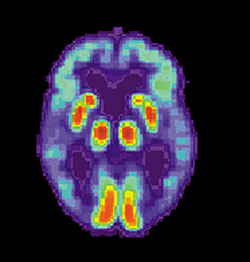
Germs May Decrease Our Chances of Disease
What’s in the Story?

You're standing in line at the store and the man in front of you has his toddler in the shopping cart. The young girl has a runny nose and keeps taking candy off the aisle display and shoving it into her mouth. You wonder how many germs this toddler takes into her body each day, and how many of her own germs she spreads to others. Would you believe that the germs she comes across in feces, on animals, in the dirt, or in the store might actually protect her from developing certain health conditions later in life, such as Alzheimer’s disease?
In the Evolution, Medicine, and Public Health article, “Hygiene and the world distribution of Alzheimer’s disease: Epidemiological evidence for a relationship between microbial environment and age-adjusted disease burden,” scientists compared Alzheimer’s disease and microbe abundance data from various countries, and found that countries with more varied and abundant microbes had fewer cases of Alzheimer’s.
Alzheimer’s Disease
Imagine you are a physician and an individual above the age of 65 makes an appointment with you to discuss their recent memory issues. Your patient begins to tell you that lately they have been having a hard time remembering what's on the grocery list or where they put their keys.

At first glance such a memory lapse appears to be a normal sign of aging, but when your patient begins to tell you that they are having a hard time recalling how to do typical daily tasks such as putting on their clothes, you begin to think something much worse could be affecting your patient’s thought processing.
After further evaluation of your patient’s mental capacity, you make the diagnosis of Alzheimer’s disease. Because there is currently no cure for Alzheimer’s, you can only prescribe medications designed to slow brain cell death, and medications designed to treat accompanying symptoms such as anti-depressants. You might even choose to use non-medication-based therapies to improve or stabilize cognitive function in an effort to improve a patient’s quality of life.
Alzheimer’s and Autoimmune Disorders
Even though little is known about the causes and progression of Alzheimer’s, scientists have noticed similarities between Alzheimer’s and autoimmune disorders. Autoimmune disorders occur when the body’s immune system sees the body’s own tissues and cells as the enemy, causing the body’s immune system to attack the cells it is designed to protect. Such a reaction has been seen in the brain tissue of patients’ with Alzheimer’s disease. This causes brain tissue death and degeneration.
One theory proposing a potential cause for autoimmune disorders is called The Hygiene Hypothesis. This hypothesis states that autoimmune disorders occur when an individual is not exposed to enough “friendly” microbes early on in life or throughout life. Since Alzheimer’s and autoimmune disorders share similar features, scientists wondered if The Hygiene Hypothesis also applied to Alzheimer’s.
Number Crunching for the Hygiene Hypothesis

To determine if The Hygiene Hypothesis could explain the onset of Alzheimer’s, scientists decided to look at Alzheimer’s rates in numerous countries around the world. When looking at the raw data of Alzheimer’s rates, scientists noticed that using Alzheimer’s as a cause of death was a flawed measurement. Mortality is rarely said to be caused by Alzhemier’s and is caused by conditions such as heart disease. To control for this, researchers used age-standardized disability-adjusted life-year (DALY) rates which is composed of the sum of the years lost due to premature mortality and the years spent in disability.
By taking into account the number of years lost due to premature mortality, DALY is successful at leaving out causes of death that people die of prior to the age of 65. Thus, researchers are able to focus on the causes of death people experience later in life, like Alzheimer’s. Additionally, by excluding the causes of death one may experience prior to the age of 65, DALY also controls for the varying life spans that are seen in different countries. For example, the life span of a U.S. citizen is not equivalent to the life span of a Malaysian citizen.
After controlling for variables seen in Alzheimer’s rates, researchers compared Alzheimer’s rates in numerous countries to each country’s respective microbe population diversity. Scientists found that well-developed countries, such as the U.S., had a smaller microbe population and less microbe diversity but higher cases of Alzheimer’s compared to underdeveloped countries. The scientists believed that well-developed countries had smaller microbe populations and less diversity than the under-developed countries because of the hygiene and public sanitation policies well-developed countries have in place. Such policies can make it hard for microbes to thrive.
I Get by with a Little Help from My Old Friends
Alzheimer’s is more common in countries with greater hygiene and sanitation and, therefore, less microbes and microbe diversity. This acts as supportive evidence for The Hygiene Hypothesis as a possible explanation for Alzheimer’s.

Throughout human history, humans have been exposed to microbes, more often “friendly” than not. These “friendly” microbes include bacteria and even viruses. Even though viruses normally wouldn't be called “friendly”, without exposure to such mildly potent microbes, our immune system would not be able to distinguish a harmful foreign agent from our own body’s tissues.
In today’s modern world we are more conscious about our hygiene and have cleaner living conditions, so we are less likely to run across various microbes. With a low amount of exposure to microbes, the immune system malfunctions because it comes across microbes so rarely that when it does detect them, it is unsure how to respond. One way the immune system malfunctions is by becoming highly sensitive to the body’s own tissues, causing it to attack. Such a response can result in Alzheimer's when the immune system attacks brain tissue. Recognizing the similarities between Alzheimer’s and autoimmune disorders brings us one step closer to understanding the causes behind Alzheimer’s disease.
Visit Digging Deeper to practice a research article critique using this article as an example.
EvMed Edits are sponsored by ASU's Center for Evolution and Medicine.
Helminth egg thumbnail by SusanA Secretariat c/o Catalina Maya Rendon via Wikimedia Commons.
Read more about: Germs May Decrease Our Chances of Disease
Bibliographic details:
- Article: Germs May Decrease Our Chances of Disease
- Author(s): Alex Biera
- Publisher: Arizona State University School of Life Sciences Ask A Biologist
- Site name: ASU - Ask A Biologist
- Date published:
- Date accessed:
- Link: https://askabiologist.asu.edu/evmed-edit/germs-old-friends
APA Style
Alex Biera. (). Germs May Decrease Our Chances of Disease. ASU - Ask A Biologist. Retrieved from https://askabiologist.asu.edu/evmed-edit/germs-old-friends
Chicago Manual of Style
Alex Biera. "Germs May Decrease Our Chances of Disease". ASU - Ask A Biologist. . https://askabiologist.asu.edu/evmed-edit/germs-old-friends
Alex Biera. "Germs May Decrease Our Chances of Disease". ASU - Ask A Biologist. . ASU - Ask A Biologist, Web. https://askabiologist.asu.edu/evmed-edit/germs-old-friends
MLA 2017 Style

Be Part of
Ask A Biologist
By volunteering, or simply sending us feedback on the site. Scientists, teachers, writers, illustrators, and translators are all important to the program. If you are interested in helping with the website we have a Volunteers page to get the process started.
